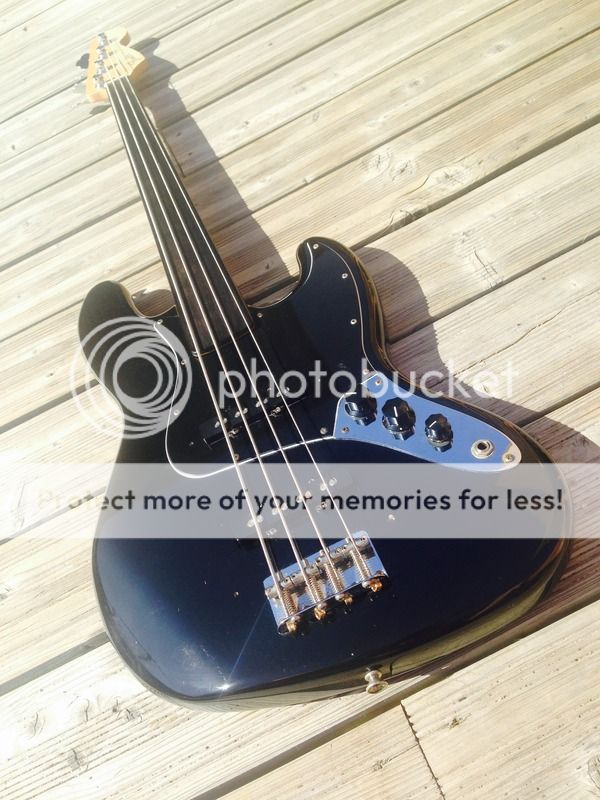-
Posts
2,215 -
Joined
-
Last visited
Content Type
Profiles
Forums
Events
Shop
Articles
Everything posted by ikay
-

FS: Fretless Jazz & Warmoth ZZ Top/Dusty Hill-alike **WITHDRAWN**
ikay replied to Beedster's topic in Basses For Sale
-

FS: Fretless Jazz & Warmoth ZZ Top/Dusty Hill-alike **WITHDRAWN**
ikay replied to Beedster's topic in Basses For Sale
-
"I want one of these..." Me too! Here's another interesting variation of a sliding pickup bass - [url="http://www.spaltinstruments.com/instruments/vviper/"]http://www.spaltinstruments.com/instruments/vviper/[/url]
-

Who can identify this bass? Dave Pegg/Jethro Tull
ikay replied to Cosmo Valdemar's topic in Bass Guitars
Hard to see. Is this pic (below) as good as it gets? -
Demo here - [url="https://www.youtube.com/watch?v=molxHHbKqbA"]https://www.youtube.com/watch?v=molxHHbKqbA[/url]
-
Ah OK, with a VVT setup of course that makes sense I've never had a problem backing off one of the pups a touch with either of my passive Js though. Maybe they both have log pots.
-
I generally play with the volume on the bass maxed so, while I can see the irritation, does it really matter? Unlike guitarists who use the vol pot for fine adjustments of tone and character etc. I wonder how many bass players use a volume in this way? I expect I'll now find out the error of my ways!
-
Warmoth do a 24 fret option for their 38mm jazz necks, or are you after something more cheap and cheerful?
-
-
Not normal no (whatever that means for a 70s Fender ), but here's another 1976 P with a similarly placed logo - [url="https://reverb.com/item/823510-fender-precision-bass-1976-black"]https://reverb.com/i...bass-1976-black[/url] Normal would be more like this - [url="http://www.vintageandrare.com/product/Fender-Precision-Bass-Fretless-1976-Natural-46183"]http://www.vintagean...6-Natural-46183[/url]
-

Different value pots, how much difference do they make on a bass?
ikay replied to a topic in Repairs and Technical
Ah. ok thanks for explaining that. The plot in your chart shows an incredibly flat response up to the resonance point which I guess is down to it being a simulation. I think that in most practical cases (with all the other various loads and capacitance etc) there would be a peak just before the cut-off point which is what gives a pickup it's distinctive tonal character. What this really tells me is that I don't understand enough about the science here and that there's a good amount of voodoo involved in pickup design and electronics! -
This thread from the Warwick forum says steel neck reinforcement introduced in 1996 for BO and 1998 for NT basses - [url="http://forum.warwick.de/archive/index.php/t-291.html"]http://forum.warwick.de/archive/index.php/t-291.html[/url]
-

Different value pots, how much difference do they make on a bass?
ikay replied to a topic in Repairs and Technical
pfretrock, can you clarify the point you make above about the resonance point? I always thought that this referred to the resonant peak of the pickup which is a distinct peak in output, not where it drops to it's lowest (as on the frequency chart below which shows the peak for various different loads). Thanks -

Different value pots, how much difference do they make on a bass?
ikay replied to a topic in Repairs and Technical
This thread from TB has a link (in the first post) to some audio clips comparing different pot values and types - [url="http://www.talkbass.com/threads/pot-shootout-250k-vs-500k-audio-vs-linear.671456/"]http://www.talkbass.com/threads/pot-shootout-250k-vs-500k-audio-vs-linear.671456/[/url] -
Pressure-wound or half-round strings usually have slightly higher tension than regular roundwounds of the same gauge. They are also a bit less bright/zingy than rounds (which you may or may not like).
-
OK, a couple of other options. If you want a genuine replacement then try contacting a few vintage guitar parts specialists (eg. [url="http://www.musicmansteve.com/parts/parts.htm"]http://www.musicmansteve.com/parts/parts.htm[/url]) and ask them to look out for one for you. Be prepared for a long wait! Or how about talking to a luthier who does vintage guitar restoration and see if they can make one for you? A quick google in your area brought up Tom Anfield Guitars in Saltash ([url="http://www.tomanfieldguitars.com/about.html"]http://www.tomanfieldguitars.com/about.html[/url]). May be worth having a chat. If he can't help he may know someone who can.
-
The original looks like an injection moulding but you could cut and shape a replacement from a solid acrylic sheet. Looks to be about 5mm thick which is.readily available on ebay such as here - [url="http://www.ebay.co.uk/itm/Black-Acrylic-Sheet-Perspex-Plastic-Panel-Material-A6-A5-A4-A3-/390782580358?pt=LH_DefaultDomain_3&var=660214772610&hash=item5afc74f686"]http://www.ebay.co.u...=item5afc74f686[/url]
-
Sure it's glue and they're not rusted in? In which case use a little WD40. If they're glued in then depends what glue was used. Acetone (eg. nail varnish remover) will soften superglue so may be worth a try. If you use heat then don't directly use an open flame which might discolour the saddles.
-
I've often wondered about using coloured wax filler sticks (furniture restoration/repair) to plug the occasional hole but not actually got round to trying it. [url="http://www.restexpress.co.uk/acatalog/Liberon_Wax_Filler_Sticks.html?gclid=CjwKEAjw2ImsBRCnjq70n_amv14SJAChXijNQSbyx2avCTDZT0XVlWJ8q-KzK_5kxj6oYpCSqASwYRoCu6zw_wcB"]http://www.restexpress.co.uk/acatalog/Liberon_Wax_Filler_Sticks.html?gclid=CjwKEAjw2ImsBRCnjq70n_amv14SJAChXijNQSbyx2avCTDZT0XVlWJ8q-KzK_5kxj6oYpCSqASwYRoCu6zw_wcB[/url]
-
This vid shows buckle rash removal using a high speed buffing wheel and a cutting cream (presentation is a bit slow, relevant bit starts about 45 secs in) [url="https://www.youtube.com/watch?v=sX3hDjanjAc"]https://www.youtube.com/watch?v=sX3hDjanjAc[/url]
-
The blurb only makes a passing reference to bass, anyone know if it goes down to a low B?
-

Difference between string-through and bridge stringing?
ikay replied to Naetharu's topic in Bass Guitars
Here's an interesting side-by-side test to demonstrate the difference (subtle to say the least) - [url="https://www.youtube.com/watch?v=6ph88gjyD-A"]https://www.youtube....h?v=6ph88gjyD-A[/url] -
That;s lovely, what a great fretless sound. Who's playing bass? Can't find much info on the web about the album 'Year' except to say that the instrumental backing was mostly piano and cello.
-
Good point, the preamp output will be low impedance which just needs a passive DI transformer. Something like a Jensen JT-DB-E - [url="http://www.markertek.com/product/jt-db-e/jensen-jt-db-e-direct-box-transformer"]http://www.markertek.com/product/jt-db-e/jensen-jt-db-e-direct-box-transformer[/url]. Here are some notes on how to build a DIY passive DI which might help - [url="http://www.diyrecordingequipment.com/blogs/news/15851820-how-to-build-a-boutique-passive-di"]http://www.diyrecordingequipment.com/blogs/news/15851820-how-to-build-a-boutique-passive-di[/url]





